Burning Man stories very often begin with a crew of friends embarking on a journey into the unknown.
This particular story began in summer 2021 when three remarkable artists from México contributed their work to the Boundless Space charitable auction. Fast forward to 2022 and the story morphs, with plot twists as extraordinary and metaphysical as the three artists’ magical realist creations. Luis Sánchez, Tania Quezada and Víctor López were invited to create murals for the interior of the 2022 Man Pavilion.
Supported by Nueve Arte Urbano founder Édgar Sánchez and producer Ivonne Uribe, the artists set to work preparing spiritually and logistically, spending long hours creating their murals, and filing the paperwork to travel into the US in time for Burning Man.
Only Édgar had been to Black Rock City before; the other four were embarking on their very first Burning Man experience. In the end, only Édgar, Ivonne and Víctor acquired visas to enter the US. Luis and Tania stayed in México, handing over their work and watching as their friends and collaborators went to Burning Man.
This video, produced by Nueve Arte Urbano, speaks about the purpose and impact of Burning Man, and introduces the artists and their work.
I first met the artists back in 2021 as they prepared for the Boundless Space auction. We spoke about their lives, work and perspectives on creativity and Burning Man. Now that they’ve made the journey, I wanted to know how it felt to be such an instrumental part of a city that, until then, had been a faraway abstraction.
Tell us about the murals you created for the Waking Dreams Man Pavilion.
Víctor: My work seeks to explore my own family and ancestors, the roots of my creativity. I celebrate this journey as a very big moment in my life, as I was able to bring a narrative inspired by my own Zapoteca ancestors to such a place like Burning Man. I consider the Black Rock Desert as a sacred place. So taking my family and identity to this ancient land within a creative endeavor is something very important in my life and work.

Tania: From the moment Édgar told me that [my murals were] going to be in the ceiling, I thought, “Okay, I can make a temple of this.” Querétaro is a really religious city and we are all surrounded by religious artworks and altar pieces, amazing works of painting and sculpture. So I seeked to recreate the essence of that in a contemporary way, by painting figures for the four directions of the world: the mother, the machine, the seed and the magic. And for me those four symbols are the things that humanity creates that keep us closer to becoming something divine.

Luis: Burning Man has a social and cultural complexity that few human endeavors have, everything that takes to perform a vast array of expressions, and make it all circle around a single culmination that thousands gaze upon. It shows you what power drives mankind and defines it, that can be found in otherwise ancestral and primordial activities. To settle, to gather up, to use natural resources and shape them, and let everything burn and weather away. I think most human acts sum up to these kinds of gestures, though we try to add dialectical complexity to our doing.
I tried to paint figures that make a narrative out of this reflection, each character is a trait of contemporary life, and mainly what I personally have experienced, which have to do with education, wealth, survival, pain and pleasure, the holy and the mundane, the godly and earthly embodiments of life. I think that many people will find a personal interpretation, and in that they will own them, if they find it amusing, they find a message or dislike them. We as creators must let our works be and release them into the world, hopefully to contribute to what horrors and wonders others may find along their way.
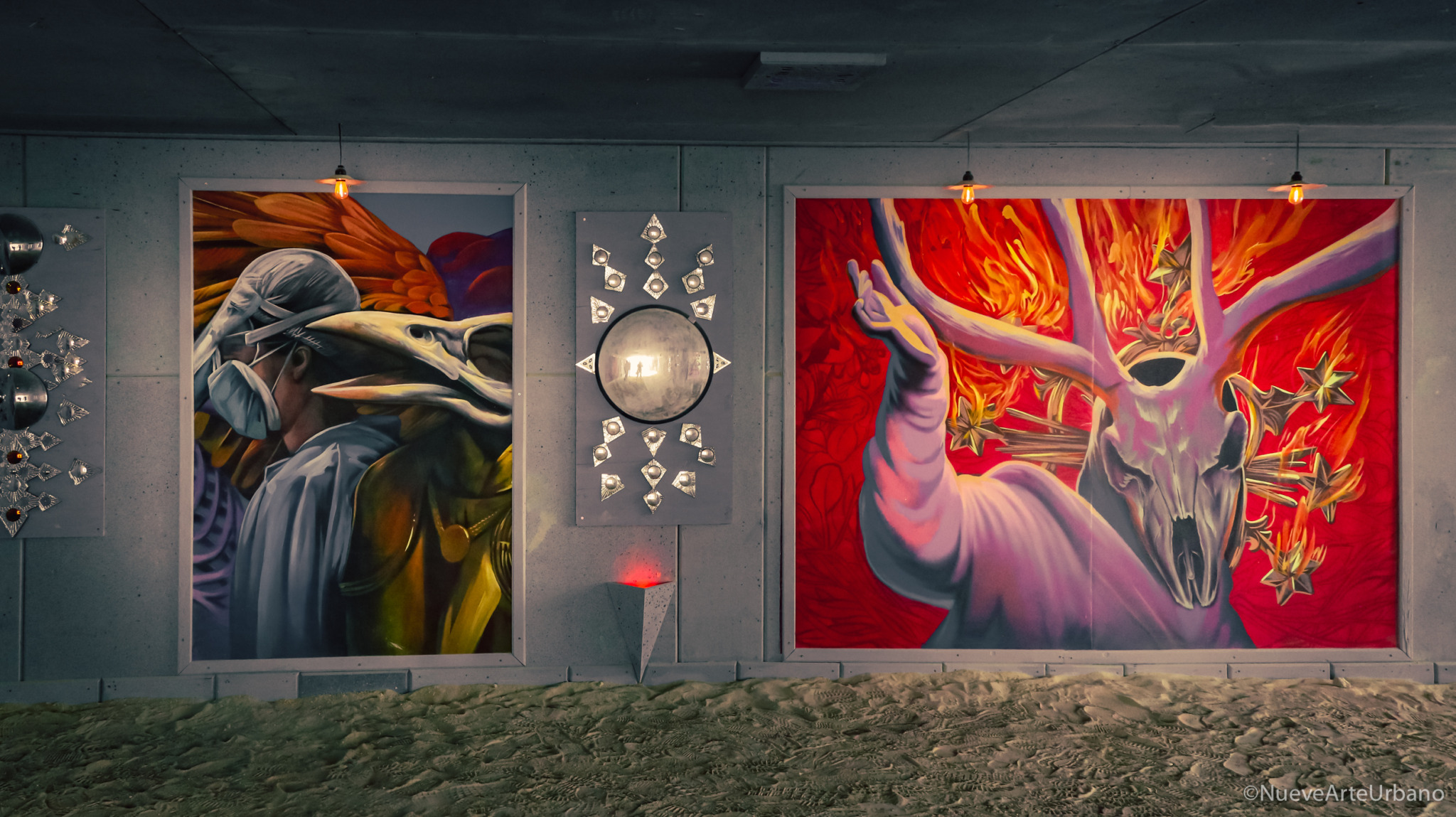
What was the journey like, from México to Black Rock City?
Édgar: When we got the invitation to Burning Man, we immediately acted, but it was not possible to get all the visas; the appointments were very scarce since the pandemic. We did anticipate this challenge, so we decided to produce all 39 canvases in Querétaro, bring them to Burning Man and staple them to the walls of the Man Pavilion. Fortunately we had a full crew with Víctor, Ivonne, Juan Carlos and the powerful vibe of the Man Pavilion crew.

Édgar: We were a crew of friends on a pilgrimage through amazing experiences. Flying to Las Vegas because this was the only place where we could find a van. And then driving for hours through Death Valley to finally enter the boundlessness of the Black Rock Desert. That very first Tuesday night, trying to sleep in a half built BlackRock City, we had a very strong storm. Our tent’s aluminum frame broke and we had to go into the van, four people inside the van [laughs], trying to sleep without moving, very, very hot. So, yes, Burning Man is a very strenuous and enchanting Communal Effort.

Víctor: I was surrounded by my friends and I felt also accompanied by my own family, even though they were not there. I experienced an intense personal process through the trip. The preparations, the driving through the land, the building part of the city and the accompaniment of all of us as a team; all these experiences helped me to prepare emotionally for the pilgrimage to this sacred place.
How did Black Rock City participants react to your murals in the Man Pavilion?
Luis: I started receiving all these messages. People wrote to me through social media, people who saw the paintings live and wanted to share their stories with me — especially [in relation to] the painting that had to do with the pandemic. For example, nurses, first responders, medical aids, the people who drive the ambulances, doctors — they all said almost the same thing: that it was a catharsis. It was cathartic for them to be shown those images.
And the curious thing is that they said that it spoke to them, especially the mural that has some sort of a parade of characters, which includes an angel, and there’s someone there with a mask on like the ones worn during the pandemic. They all said that they touched really sensitive things within them, but I think they all had a personal interpretation; they all owned the art in their own way, experiencing through the painting.
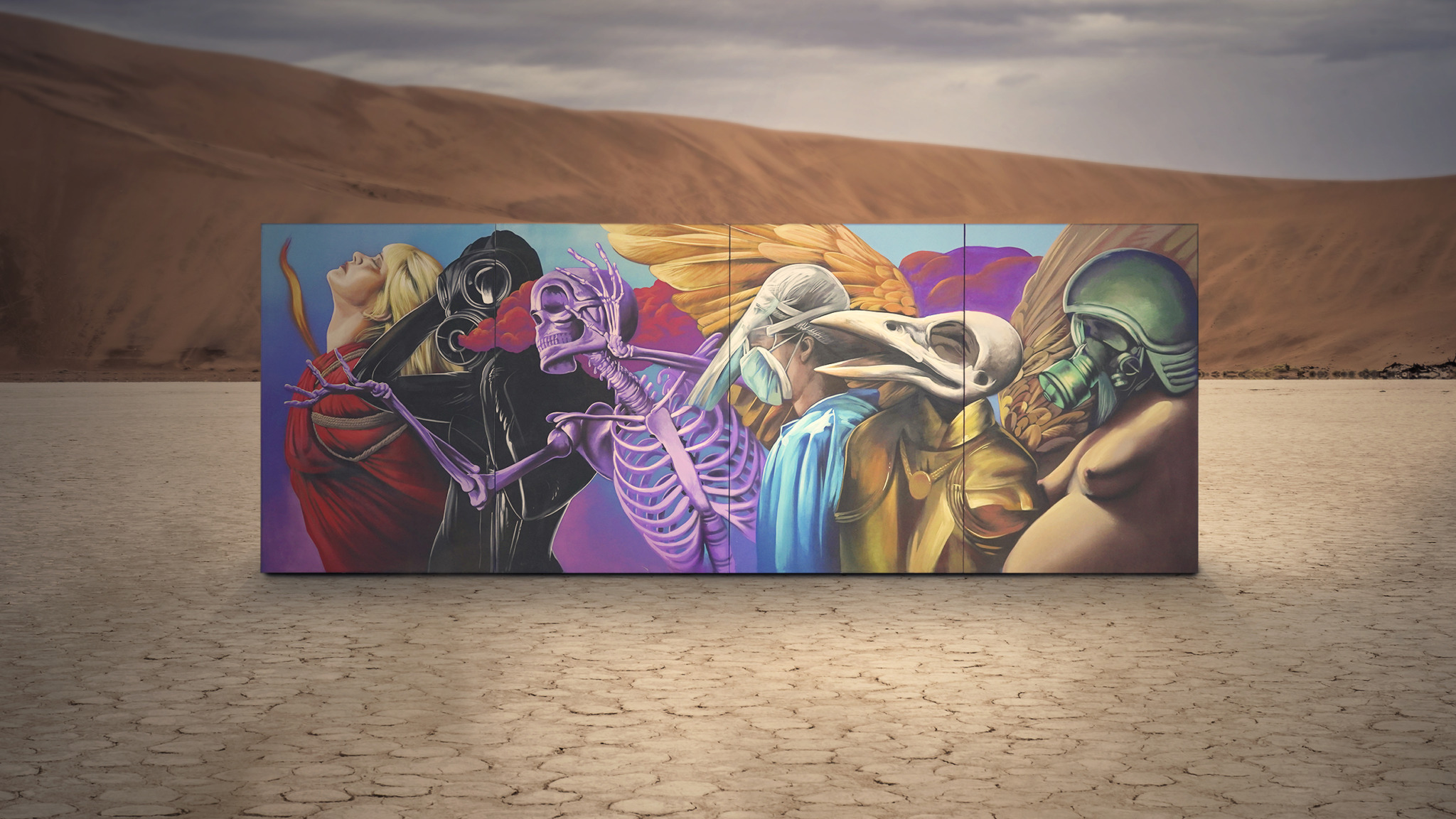
Tania: When I saw the images that Víctor brought to us and the experiences that he had there, he said he watched so many people connect with my work. Lately I have had these messages on social media, they were like: “We were searching for almost a year to find you because we didn’t know who you were.” I have all these beautiful messages from people who really connected, understood that piece.
Víctor: Amazing, incredible, yes. There was a magic connection beyond culture, beyond the language through the ancestors. Because no matter what culture or language, all of us, we can connect with the idea of the ancestors giving us the power to go on a pilgrimage. There were moments when people would show their feelings while contemplating my work, my family. I’m working with my family and people are reacting to my family — but in fact, it was a true connection within themselves.
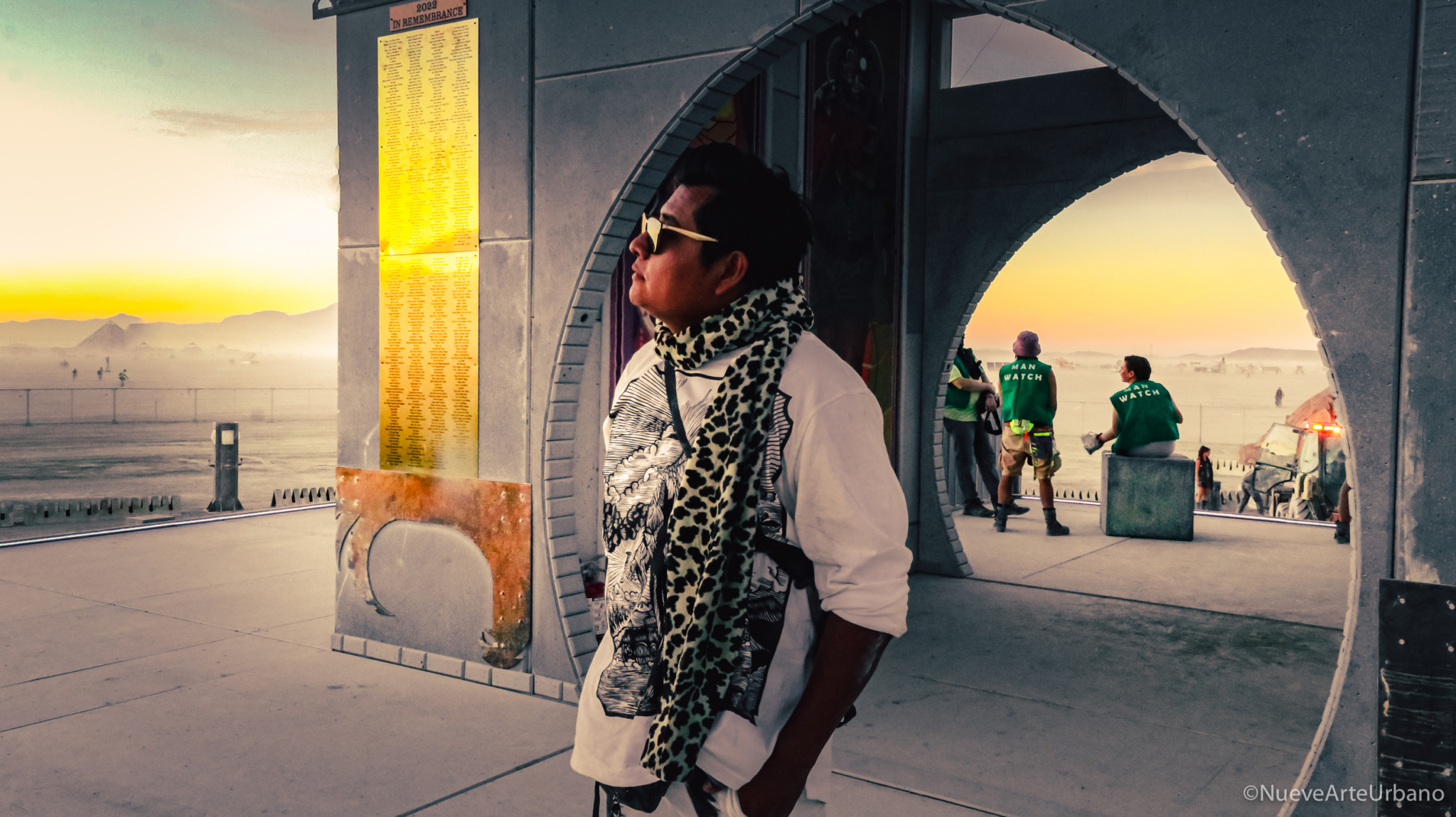
Édgar: I saw many people shedding tears or asking for the artist, for Víctor, connecting with the art. And it was every day, all day, so it was emotionally difficult for us to stay there [at the Man Pavilion] because it was very intense. We would end up crying or something like that. People were celebrating engagements or doing impromptu ceremonies. All the time there was something happening right there in front of the murals and the Man.
How did it feel to contribute such an essential element to Black Rock City?
Tania: When you send your work, it’s part of you. Working to put something in a place that you’ve never been and in a building that you have never seen physically before you make the work, it was a very surreal experience because we had to connect in a spiritual way to the event first.

Víctor: Burning Man is a creative utopia. The possibility to experience a utopian community in which you can create is a very rare opportunity. We should remember that this utopian community is about including everyone, all kinds of cultures, and in fraternity and equality.
Ivonne: My heart crashed towards my mind, and then I just knew that we were going into something great. It was a monumental challenge. It was a great joy, but also a great challenge. It changed my perspective in many areas of my own life.
What was it like collaborating with the Man Pavilion crew to install the murals?
Édgar: The Man Pavilion crew is amazing. When we got there, they had already brought the pieces from Reno and they were perfectly preserved. They gave us tools that we were not able to carry in the airplane or get [in Reno]. They made us feel at home immediately, they even played Mexican music and shared precious hydration. We were very happy working with them in the middle of the storms.

Édgar: Then one week later we enter into strike night and there’s a big storm and suddenly it’s like an apocalyptic scene. Lots of machines are coming and the visitors are being asked to leave and suddenly there’s a fence around the Man and we’re deinstalling the pieces with a lot of help. It was a very energetic night. It was very hard work. No one got hurt.
We were all happy working in the middle of the night and I was so excited that night that I could not sleep. We were leaving the next morning very early and I could not sleep. So when we finished and we placed the artwork in a safe place, I just went out walking until the sun came up because I felt so full of energy. This is the beauty, this is the gift that Stuart [Mangrum] speaks about. This whole place is a gift and it’s a great work of communal art. It’s really amazing.
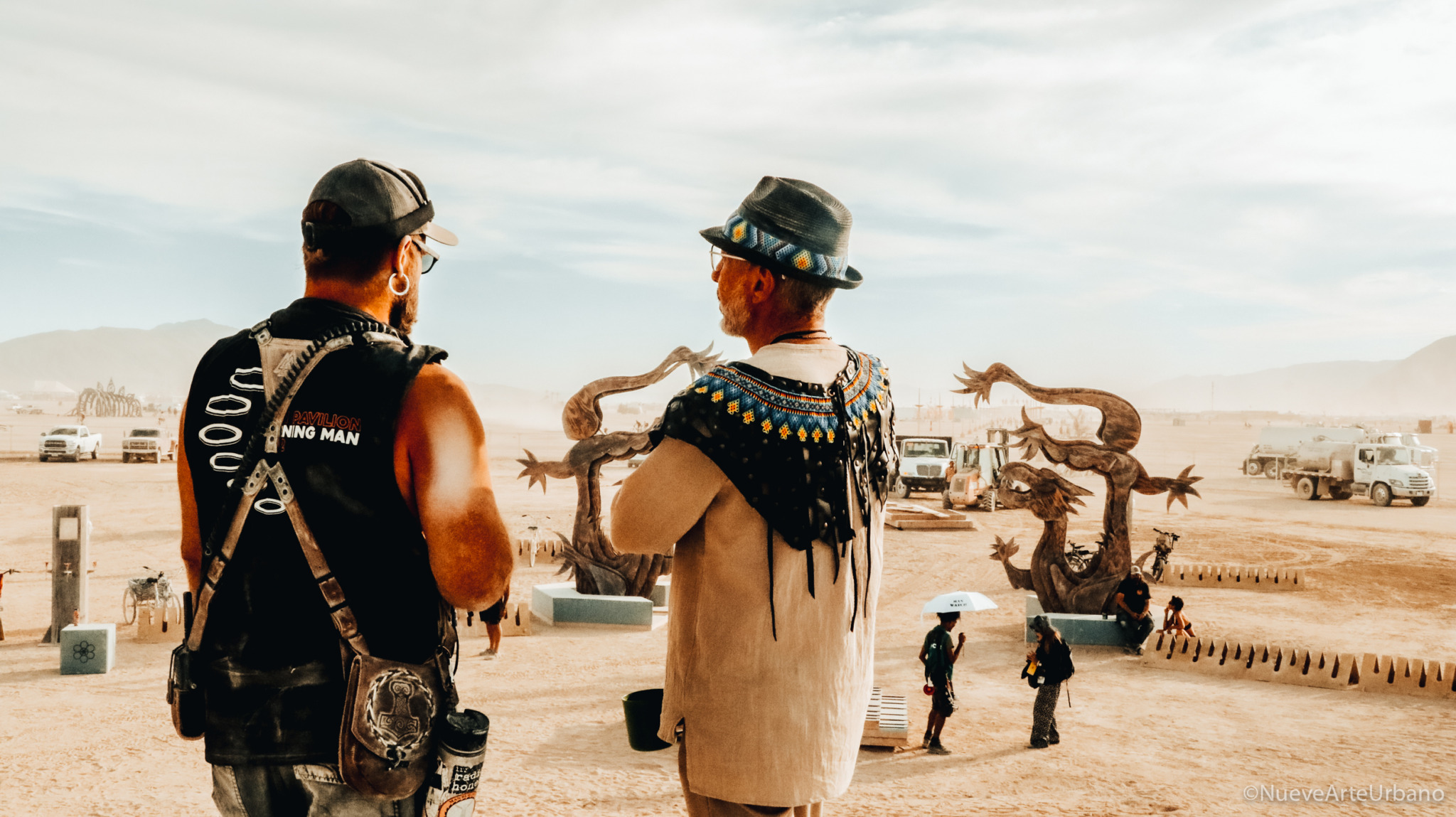
You brought all the murals to Black Rock City, and then they went back to México. What’s next?
Édgar: We worked about four hours on strike night and carried the 90 pounds of canvases all the way back. We will exhibit them in the most important museum in town, Museo de Arte de Querétaro, on May 3. We are working to show not only the murals that we took to the Man, but also the pieces that we did for the party in México City, the Boundless Space altars, and also the new pieces that are part of the calligraphic art book “Intersección Nueve.”
The murals are created as a series of polyptychs (paintings with several panels), so we will now install them all together as murals, to make a different experience from the desert. After this exhibit we will continue showing our work to inspire other Mexican emerging artists.
Luis: Not only was it an amazing project, but it was life-changing for me. I still have to have that experience. It’s not something that I pursued. It was something that came up, and now it’s something that I really have to do… not only to go there, but also to make something big. It’s something that grows inside of you. If you’ve had a little taste of it. You really have to have more of it. It’s a huge ambition for me to give something back as it’s been given to me.
Cover image of Víctor López at the Man Base (Photo courtesy of Nueve Arte Urbano)

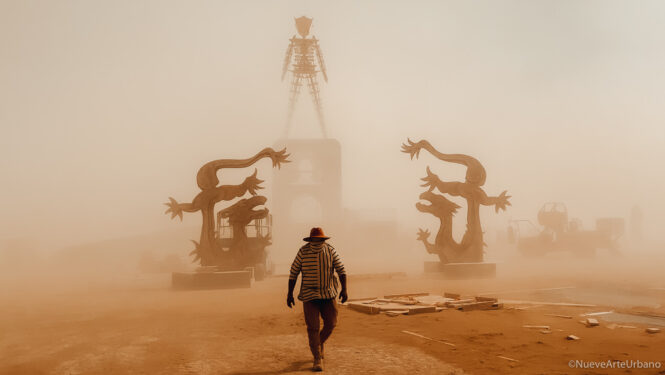
I would love it if there was share button on these specific articles. Que viva Mexico.
A los artistas, mil gracias por compartir su talento, su inspiración y su arte con nosotros. Sabemos que es un gran sacrificio de tiempo y finanzas. Son ustedes un regalo. Mil gracias. Xoxo
Report comment
Gracias <3
Report comment
Comments are closed.